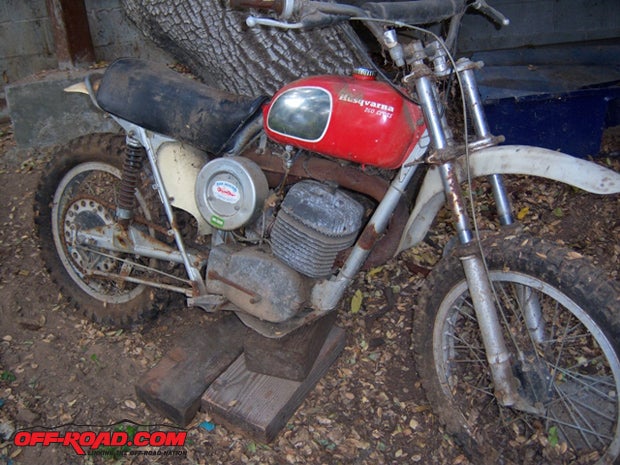
The man who found and saved this rare bike is Rob Phillips. He owns a small company called Husqvarna Restorations. Rob has done a number of very famous bikes throughout the years, including other bikes owned by Steve McQueen.
This bike is unique in that it was built by Solar Production, a company owned by McQueen. It’s the only custom modified Husky, and maybe the only motorcycle period that McQueen ever built from his own parts. It was built for high-speed desert racing and registered with the California DMV August 15, 1971. This document confirms this Husky was custom built and owned by McQueen. The other side of this document shows frame number and owner as McQueen.
For its time, the bike was very state of the art. It is one of the most extensively modified Husky 400 Cross I have ever seen. There is a special ending to this story that will amaze you. If you’re a McQueen fan, you will be an even bigger fan when you hear the ending.
-Rick Sieman
***
In January 2010, I purchased the bike from the second owner. The engine was dismantled so the cases could be sent for X-ray to see if we can get the original engine number off the case. Unfortunately, no results. The original number was ground down, leaving no evidence.
Added more evidence from several documents from Edison Dye records to bottom of this page, 1/22/71 being most important with rare titanium bars and other parts matching right up with the bike.
Update: 1/1/2011 Email from Don Rickman. The frame was not modified by them.
Update: 11/27/2010 - Trying to determine who might be responsible for the frame modifications. I contacted Simon Cheney of famous Cheney Racing frames in UK. Simon said that his dad did do a fair amount of work for Steve but it appeared the frame was TIG welded. He said his dad did not use TIG back then for their frames.
Engine restored internally by Rick Horvat – Koni Shocks rebuilt by Koni King, Steve Dorenkamp.
***
This story begins in January 2010. I was told the bike was built by Solar Automotive, Steve McQueen’s silent company. The story gets a little technical, but stick with me. I purchased this very cool old school (Frankenstein) Husky from a gentleman named John. He did not have any photos of the bike, so I went by his description to buy the bike. He told me about some really nice design changes done to the bike, so I bought it. He retired the bike to under his porch in 1978, where it stayed until January 2010 when I bought it. Since it was a L.A., Calif., local bike, it weathered well, so to speak. The owner told me the bike came from Solar Automotive and that it was heavily modified.
I eventually received some photos from John. The bike was in pretty sad shape, but it was complete. In March, I finally got the bike to New York. Close inspection shows front brake hub as being a smaller 250, and the fuel tank says 250 Cross, but the engine and frame are pure 400. Front forks were lightened, steering triple tree cut for lightening and handle bar mounts raised one inch.
The neat part was the handlebars were Titanium. The levers and throttle were original Magura, but the grips were made by a Los Angeles, California, company called CAMCO. The rear swing arm is stretched one inch, reinforced top swing arm gussets, and the lower shock mount moved forward. To top it off, a nice set of Koni shock absorbers were installed. The engine is an original 400 with 400 pipe.
The carburetor is a Bing, and the air cleaner bracket is a one-piece aftermarket item. Close inspection of swing arm shows it has a 10mm swing arm axle. This puts the bike into 1970.
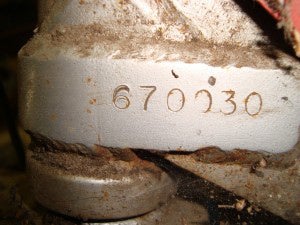
Here is where it gets interesting. The bike was built by Solar. You might ask, so what are the frame and engine numbers? Well, they are not original and they were stamped in by Solar. Why? Because this 1970 frame is stamped 670030, which anyone with Husky frame number knowledge knows this is a fabricated number of their own. To make matters more puzzling, the engine is stamped with the same number, which is also incorrect, since 400 engines start with 400,401, 402 or 403. I showed this to Don Ince and my friend Christer in Sweden and we agree it appears to be a stamp over on the engine. I am planning to pull the engine to see if we can do some forensics to determine the original engine number. Usually the engine number are under cylinder head on the left side. It is blank on this engine.
NOW THE CLINCHER!
Good old buddy Don Ince of (http://vintageviking.com/) found a Med International document dated Jan. 1971 signed by Edison Dye and invoiced to none other Solar Automotive Steve / Don. Don is Don Mitchell, Steve’s race manager. The invoice is for a replacement frame and it states that Steve’s original frame was broken in two places.
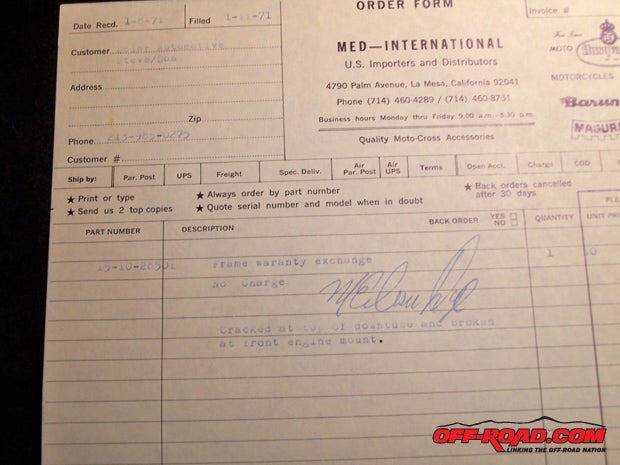
Now back to the frame number. Replacement frames do not have frame numbers stamped on them, which explains how a frame we know came from Solar was able to be stamped with a new number on a original blank surface. Why did Solar stamp this number and what does the number represent?
Also on the document is a note (not shown) to Pierre, Edison’s shop foreman, to give Solar the aircraft bolts they got from Rohr aircraft. Well, there are a number of aircraft bolts on this bike. I looked at a few of the bolts. On the head of some of the bolts is a number. Seeing them without a magnifying glass the first letters look like ROHR for the aircraft company. The original ROHR Aircraft is gone, but there is a website of Rohr employees, alumni. I emailed them and they responded saying Rohr did not make their own bolts.
I viewed the bolt again with a magnifying glass and saw RD111. Close to ROHR. Now I had a real number and tracked it down to a company making aircraft bolts. I emailed them the bolt number and they kindly replied with basic information on the bolt, but they said they could not give me anymore information because the information is proprietary to Pratt and Whitney, Rocketdyne. What? I emailed the company back thanking them and told them about the motorcycle. The person responds with, I guess McQueen only puts the best on his motorcycles because those bolts are made only for rocket engines.
A closer look at the bolts on the whole bike shows a few original bolts, a few aircraft bolts, four titanium bolts to bolt the engine on and, of course, you just got to have rocket engine bolts holding your shocks on.
***
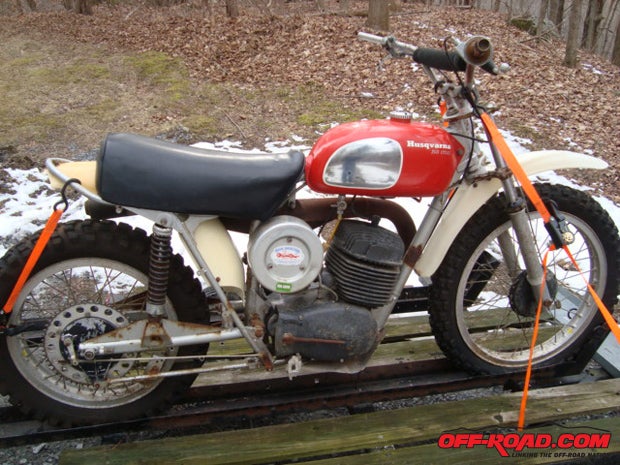
The motorcycle was filthy from 32 years of being under the porch, so I decided to take the bike down the local car wash to use the high pressure sprayers. After about 30 quarters, I noticed all of a sudden the paint was coming off the frame.
Since I have restored a bunch of these bikes, this should not be happening. So I looked at the frame under the paint and it is shiny. I know chromoly can be polished to be shiny, but this did not look right. I left the car wash puzzled and stopped by a friend’s body shop and showed him. He knew right off: “That’s what I did to my race car; it’s nickel plated.” You got to be kidding me!
I took the bike home and saw that the frame, foot brake lever, brake rod, brake stay, chain guide, skid plate and swing arm were all nickel plated. I spoke to the last owner Jim and he said he knew nothing about this.
A few nights passed and I started cleaning the bike up more, and noticed the center exhaust bracket was almost twice as long as normal. I took the pipe and seat off, and would you believe the frame had been cut at the seat area, rear hoop connections were re-done, a gusset plate welded in, and because the rear hoop section is tapered in the front, the seat pan was also tapered in to match the hoop. I then saw up front there was a one-inch piece welded into the front down tube. So prior to nickel plating, the upper frame section was raised an inch. The reason for this, I am sure, was to lower the CG of the bike and increase the wheel base. Wheel base was almost three inches longer than stock now. WOW!
I started dismantling the bike. Like my other McQueen bike, the plan was NOT to restore this bike, but to give it a super cleaning.
It had a nice set of 12-inch Koni’s, which I took off so I could have the internals rebuilt. Not in bad shape, but the seals were shot, as you might expect. I removed the engine for a ‘Internal” rebuild. I noticed a few things unusual with the engine. The first was a large, very short, aircraft bolt was built into the top left side cover as a second oil fill hole. The original right side filler cap and vent hose was modified and fitted with a 3/16-inch steel-braided hose and fitting? The engine side cover bolts were high-strength Allen cap and they were nickel plated.
The another unusual item was the engine color. It looked like a very faded black, almost Titanium looking, but the problem with that is it was uniform over the entire engine. I took a photo of it with a normal cover so you can see the difference. What is that all about?
Update May 13, 2010: Thanks to Rick Horvat, the engine coating was identified as Kal-Gard. I tracked the company down who are now called KGcoatings. I spoke with Chris Fazio, General Manager, who was very helpful. He spoke to the original founder Joe Ardigo of KalGard, but no records exist. Chris believes the coating is their 2300 Original Gun Kote. I have to say for almost 40 years old, this coating was in remarkable shape. You’ll see it in the final steps of the clean up. Chris says the coating is impervious to any chemical, so I expected a nice clean up. After seeing this I’m sold on this product. Great stuff. See it at http://www.kgcoatings.com/.
I took the rear wheel off. Changes: Axle thread changed to fit the multi-spline 7/16 aircraft nut. Custom chain tensioner spacers were made of aluminum and extended to cover the aircraft nuts. A 7/16 socket fit perfectly inside.
Rear brakes are stock but the brake plate bushing is now aluminum. The brake stay and chain guide are nickel plated, with aircraft bolts used and the brake stay stretched one inch. You can see the stretch next to the chain guide.
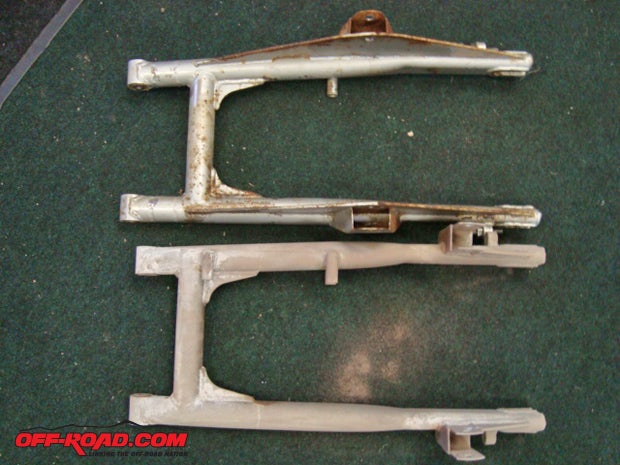
Rear swing arm was nickel plated and stretched at the rear one inch. Shock mounts moved forward four inches. Minus the one-inch stretch, the shock is three inches forward from stock. That would open the top clearance above the wheel and really change the geometry of the suspension. Top surface of swing arm heavily gusseted. I placed a normal swing arm along side.
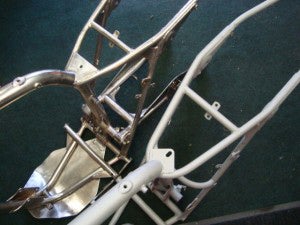
Here is where the frame was stretched. Rear hoop connections were tapered in. Large gusset added.
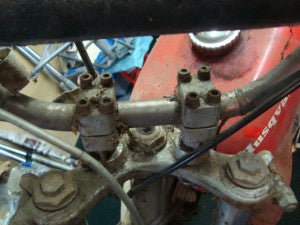
The front down tube was lengthened. Titanium handlebars were raised one inch.
Triple tree clamps were cut to save a few ounces.
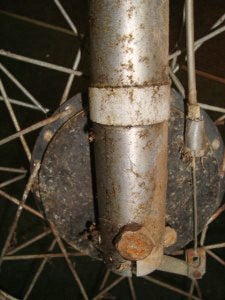
The front forks were turned down to reduce weight. Almost a 1/4-inch was taken off the diameter.
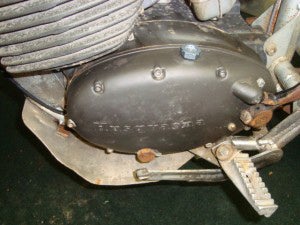
The aftermarket air bell bracket and foot pegs. Don said Edison Dye did sell those type of foot pegs.
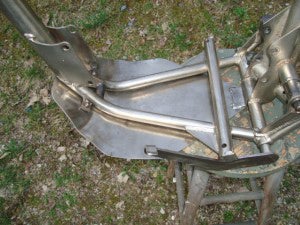
Here’s a look at the skid plate. The plate is original but it is nickel plated. Tabs were welded to the frame to eliminate the original clamp. You can also see this unusual color to the engine side cover and a good shot of the left side oil fill plug.
***
NOW FOR THE CLEAN UP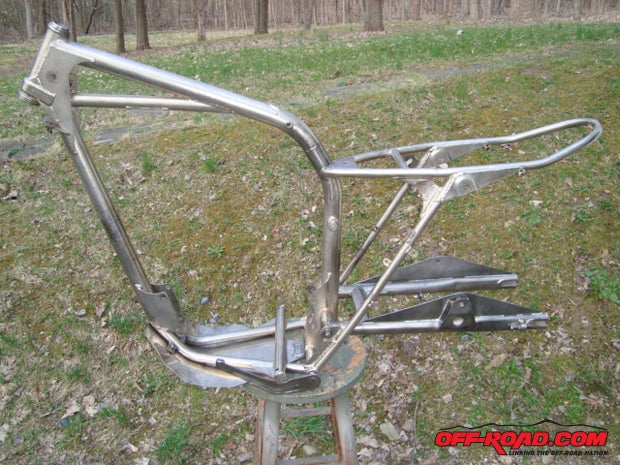
The swing arm stretched and chain wear strip welded above the mount.
This is where the lower hoop use to go from side to side. You can see the patch on the center of the down tube. Above you see the frame extended, front tube, rear hoop tapered in and gusseted.
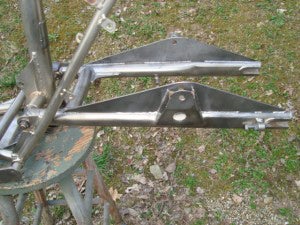
Rear hoop gusset cut and spacer welded in. This is a side by side comparison of the Solar frame and a stock frame. Nickel plated skid pad. Tabs for skid plated welded in and a extra tube in center welded in joint of Y section. Nickel plaSSShock mount moved three inches forward from the stock location.
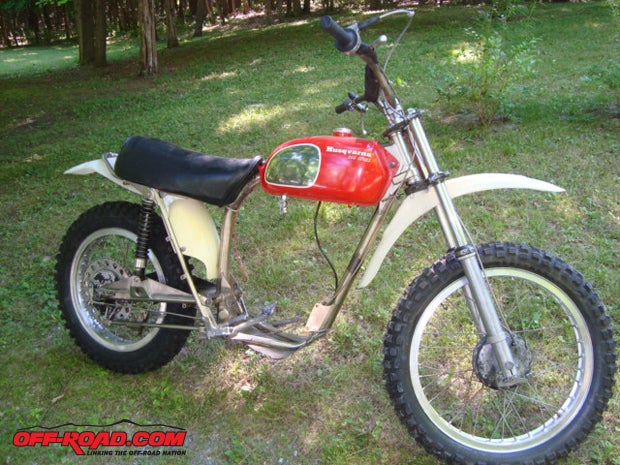
SHE’S FINALLY DONE AND RUNS LIKE A CHAMP
Update 2/13/2011: I finally got around to reviewing a few Edison Dye invoices that I have on this bike. All these invoices are address to Solar Automotive Steve/Don.
• Document dated Jan 8, 1971 is the main document where Solar gets replacement 400 frame.
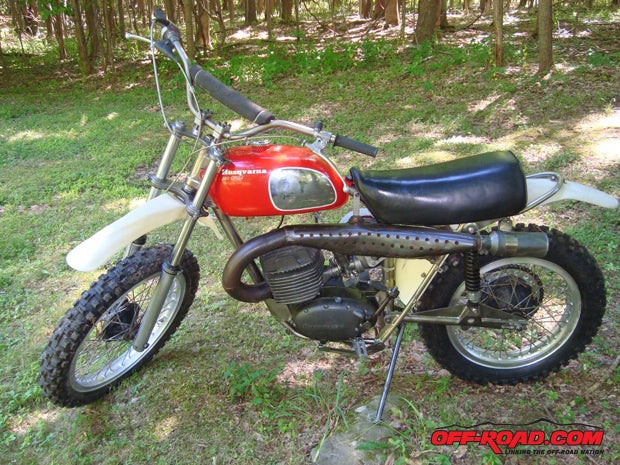
• Invoice 1/22/71 List following parts: Titanium Handles bars – Number plate set – Front and rear AA plastic fenders -Inner Plastic fender Viking vinyl air cover – lever covers and Sub note to Pierre from Edison, Send aircraft hardware from Rohr. Everything but air cleaner cover and number plates are on the Solar bike.
• Invoice #012-21 Address to Solar: Tool kit – MH manual – Alloy foot pegs. Foot pegs are on Solar bike.
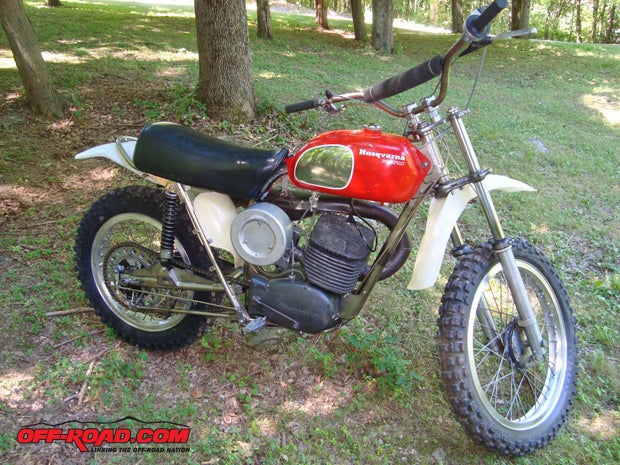
• Invoice. Torn and missing # but says Solar on lower left and there are letters in upper torn area showing Don’s Mitchell name and part of their phone number.
• Parts list: Sprocket – Trailing arm – Chain Guide – Fender rear - Front Fender – Manifold.
• Air cleaner cover – Carb complete – Pipe – fuel cock._
• Happy ending, McQueen documents found.
CONTACT
Phone: Rob Phillips at 845-889-4499
Location: New York
Email: artrob1@optonline.net


 Your Privacy Choices
Your Privacy Choices